Common Shed Sizes to Buy
- July 7, 2023
- 0 comment
Choosing a shed isn’t just about finding a place to stash your gardening tools. It’s about finding a solution that fits your lifestyle, complements your home, and brings value to your daily routines. Let’s explore the world of sheds, sizing, and the unique benefits each one brings.
What Size Shed Do I Need?
The size of the shed you need depends on a few factors:
- Purpose: Are you only storing tools or do you plan to use them as a workshop, office, or hobby room?
- Items to Store: The size and quantity of items you plan to store will determine the space you need.
- Available Space: Your garden’s size will also dictate the maximum shed size you can accommodate.
- Future Needs: Consider your future requirements as well. If you plan to buy more tools or start a new hobby that requires space, you may want a larger shed.
- Local Regulations: Some regions have restrictions on shed sizes or require permits for larger sheds. It’s crucial to check this before making a decision.
What are the shed sizes?
Small Sheds (6’x4′, 7’x5′)
Small sheds, which typically measure from 6’x4′ to 7’x5′, are often overlooked due to their diminutive size. However, what they lack in square footage, they make up for in their surprising versatility and space efficiency. These petite structures, fondly termed powerhouses, are ideally suited to urban gardens and compact outdoor spaces, providing adequate storage solutions without overwhelming the available area.
Small sheds may appear limited but they efficiently store a surprising variety of items. From housing essential garden tools such as rakes and spades to providing a safe refuge for your foldable outdoor furniture during harsh weather conditions, these sheds are resourceful in keeping your garden uncluttered. This makes them an invaluable asset for those with smaller yards or patios, or for those who simply don’t require a large storage space.
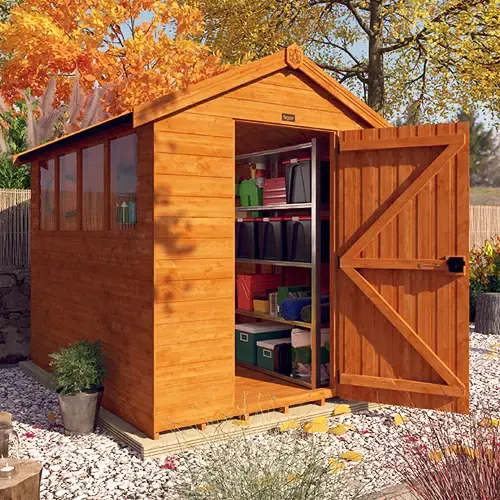

But the utility of these sheds extends beyond just storage. They can serve as an aesthetic addition to your garden or outdoor space. For instance, small sheds can be dressed up with climbing plants such as roses or ivy, which not only soften their appearance but also integrate them into the overall garden landscape. Their exterior walls can also serve as a canvas for your creativity. Applying vibrant paint colors, or using decorative elements such as a trellis or window boxes, can transform your small shed into a charming garden feature.
In essence, these small sheds, while practical, also offer you a unique opportunity to enhance your garden’s visual appeal. So don’t underestimate these compact structures; they’re here to offer more than just storage solutions. With a bit of creativity and planning, they can truly elevate the aesthetics and functionality of your outdoor space.
Medium Sheds (8’x6′, 10’x8′)
As we ascend in size, medium sheds, measuring 8’x6′ or 10’x8′, come into the spotlight. These structures strike a harmonious balance between remaining compact and providing increased storage capacity. They are particularly appealing to ambitious gardeners or DIY enthusiasts who require more room to breathe and explore their interests.
Medium sheds offer a storage boon for those larger, often cumbersome, items that we love but struggle to house. This might include bicycles that have been cluttering your hallway, or BBQ grills that somehow never fit comfortably into any corner. Moreover, they provide an ideal shelter for bulky garden machinery, like that hulking lawnmower that has been greedily occupying your garage space.


Yet, the potential of medium sheds extends well beyond storage. With the additional space, they also provide an opportunity to create a multi-functional environment. Consider installing shelves to organize your tools, garden accessories, or pots. You could even fit a sturdy workbench and transform part of your shed into a potting station, creating a dedicated space for nurturing your seedlings and potting plants.
For the DIY enthusiasts among us, a medium shed can be the perfect spot to delve into projects. Whether it’s crafting homemade furniture, repairing household items, or any other creative venture that has been dancing in your thoughts, a medium shed provides the space to spread out your materials and work in peace.
Ultimately, medium sheds often evolve to become the heart of the garden. They morph into vibrant hubs where garden maintenance tasks come to life, hobby projects find a home, and preparations for family BBQs or other gatherings are made with joy. The opportunities with medium sheds are as diverse as they are enticing, making them a worthwhile consideration for any garden owner.
Large Sheds (10’x10′, 12’x8′, 12’x10′)
Large sheds, which typically measure 10’x10′, 12’x8′, or 12’x10′, offer a sanctuary for those in need of ample space and maximum flexibility. These structures are tailored to meet the demands of homeowners with extensive storage needs or those wishing to create additional functional living space within their garden environment.
The sizeable interior of a large shed provides an ideal home for larger garden machinery or equipment. If you own heavy-duty items like ride-on mowers, or even small boats or jet skis, a large shed can accommodate these with ease. The spacious layout allows you to organize your items strategically, making it simple to access your belongings when needed.

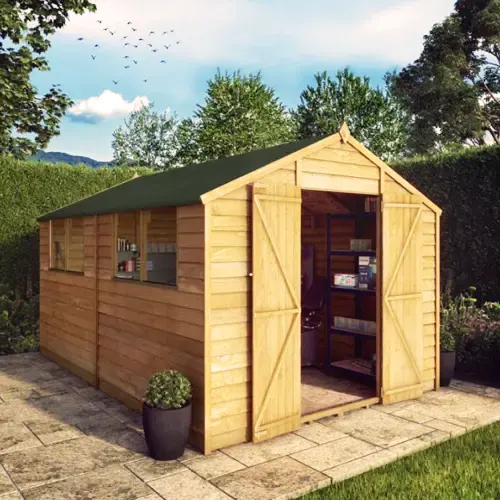
However, the potential of large sheds extends far beyond merely storage. Their dimensions can allow for the creation of specialized spaces that align with your lifestyle or interests. Have you always dreamed of your own woodworking shop where you can craft and create to your heart’s content? Or perhaps a tranquil yoga studio, where you can stretch and meditate in the peaceful seclusion of your garden? Maybe the idea of a serene garden office, far from the noise and distractions of your home, has always appealed to you. All these possibilities, and more, can become a reality with a large shed.
An added benefit of these spacious structures is their ability to accommodate vertical storage solutions. The elevated ceiling height often allows for the addition of loft spaces or high shelves. These features can significantly increase your storage capacity, providing a place for items that aren’t frequently used or need to be kept out of reach, such as seasonal decorations or hazardous materials.
In essence, a large shed serves as a testament to the fusion of practicality and creativity. It offers not only substantial storage space but also the flexibility to personalize and use the area in ways that can enrich your daily life.
Extra Large Sheds (14’x10′, 16’x12′)
Extra large sheds, typically measuring 14’x10′, 16’x12′, or even larger, are the ultimate solution for individuals seeking maximum storage and multi-purpose functionality. These buildings stand as giants within the realm of garden storage solutions, blurring the lines between an outdoor shed and an additional living area. The copious space within these structures stands ready and willing to accommodate your most ambitious needs and dreams.
Imagine having the luxury of wandering down your garden path to a spacious art studio, where you can let your creativity flow without space constraints or interruptions. Or perhaps, consider the convenience of a backyard gym, fitted with all your preferred workout equipment. No longer would you need to worry about the commute to a public gym or working around its operating hours; your personalized fitness center would be right at your doorstep, ready for an energizing workout whenever you please.
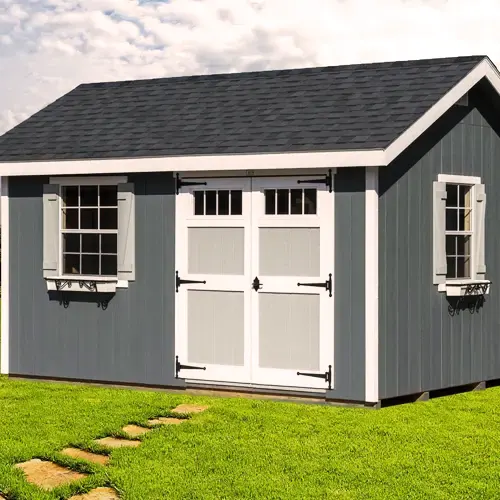
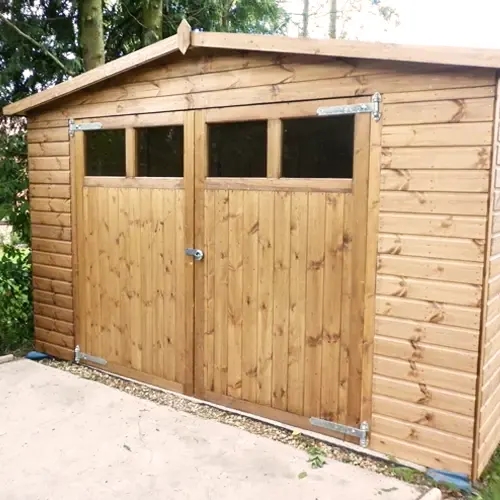
For those with large storage requirements, extra-large sheds are a godsend. Whether you need room for a family fleet of bicycles, a collection of antique furniture, or even a classic car, these substantial structures have the capacity to house them comfortably.
The versatility of an extra-large shed allows for another layer of customization – internal partitioning. Creating different zones within the shed can offer improved organization and convenience. For instance, one section could be designated for storage, another for work or hobbies, and yet another for relaxation or exercise. The possibilities are virtually endless.
In summary, extra-large sheds take the concept of garden storage and transform it into something much grander. They provide not just a place to store items, but a space for pursuits, passions, and peace – a space that is as diverse and expansive as your imagination allows.

What Is the Most Popular Shed Size?
The 10’x8′ shed is often recognized as the most popular size. This provides ample space for general storage needs like garden tools, bicycles, and lawn mowers, while still fitting comfortably in most gardens. It also offers enough room for shelves or a workbench, making it versatile for different uses.
What is the Average Storage Shed Size?
The average storage shed size is typically around 10’x8′ or 10’x10′. These sheds provide an optimal balance of storage capacity and spatial footprint, making them suitable for the average homeowner’s needs. However, the “average” can vary depending on individual storage needs and available yard space.
What Is the Typical Garden Shed Size?
The typical garden shed size is usually 8’x6′. This size is compact enough for most gardens and provides sufficient space for storing garden tools, pots, and other essential gardening items. It can also accommodate a small workbench or potting area.
Additional Key Considerations and Questions to Ask When Purchasing a Storage Shed
When acquiring a shed, several vital aspects warrant your attention. Let’s briefly explore these critical points, with more comprehensive insights available on separate pages.
- Permits: Before delving into your preferred shed type, it’s wise to investigate local code requirements. You might need a shed building permit and could be subject to municipal or zoning constraints. If your residence is governed by a Homeowners Association (HOA), specific regulations may apply to outdoor storage structures.
- Foundations: A solid shed foundation is paramount for optimal protection. It should be level, stable, and facilitate proper drainage. Ideally, the shed should be elevated several inches above ground level. Your shed manufacturer may offer foundation guidelines.
- Siding and Roofing Materials: Prioritize quality siding and roofing materials that offer durability and longevity.
- Thorough Planning: Beyond storage, anticipate how you’ll use your shed. Strategic planning ensures essential features align with your needs, unlocking your shed’s full potential.
- Aesthetic Design: The shed’s appearance significantly impacts your property’s overall aesthetics. Opt for a custom shed style that harmonizes with your home’s design.
- Flooring: Shed flooring varies; wooden sheds often have plywood floors, while plastic and metal sheds might require separate flooring purchases.
- DIY vs. Professional Installation: If cost-efficiency is a priority, consider DIY installation or ready-made kits. Alternatively, professional shed builders can assemble on-site.
- Site Preparation: Select a location that allows for maintenance, avoids utility lines, and offers level ground.
- Door Placement: Choose door placement based on whether you’ve opted for sliding or hinged doors, considering accessibility needs.
- Insulation: Effective insulation converts the shed into a comfortable, usable space, safeguarding items from extreme temperatures.
- Electricity, Lighting, and Heating: Enhance versatility by incorporating electrical, lighting, and heating options.
- Static vs. Portable Shed: Your shed choice depends on the intended use and the possibility of future relocations.
- Interior Enhancements: Simple additions like windows, partitions, storage solutions, shelving, hooks, or French doors can vastly expand a shed’s utility.
- Warranty Scrutiny: Always review and comprehend the warranty’s terms and conditions to ensure comprehensive coverage.
Frequently Asked Questions
- Are there any local regulations for installing large sheds? There may be local regulations regarding the size, location, and design of sheds. It’s important to check with your local council or homeowner’s association before installing a large shed.
- Can I convert a large shed into a living space? Large and extra-large sheds can often be converted into additional functional living spaces like an art studio, a home gym, or even a garden office. However, ensure to consider aspects like insulation, lighting, and whether your local regulations permit such conversions.
- How do I maximize the storage capacity in my shed? Installing shelves, and hooks, and using vertical space efficiently can help maximize the storage capacity in your shed, regardless of its size. In larger sheds, you might even consider internal partitions to better organize your space.
- What factors should I consider when choosing a shed size? When choosing a shed size, you should consider the available space in your garden, the purpose of the shed, future usage, potential growth, local regulations, and access to the shed.
- Can I extend my shed if I need more space in the future? While possible, extending a shed can be complex and may require planning permission. It may be more practical to consider your future needs when choosing your initial shed size.
- How much does a larger shed cost compared to a smaller one? Larger sheds typically cost more than smaller ones due to the increased material and labor costs. However, the exact cost can also depend on factors like the shed’s design, materials used, and any additional features.
Your insights matter to us! Feel free to share your personal experiences and thoughts regarding common shed sizes to buy in the comments section below. Your valuable input has the potential to guide other buyers in making well-informed choices when it comes to selecting the right shed dimensions. Thank you for contributing to the discussion!


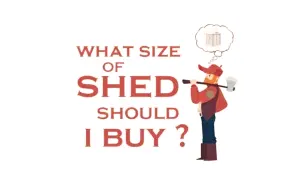
Leave your comment